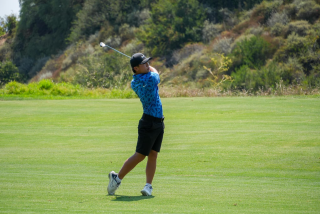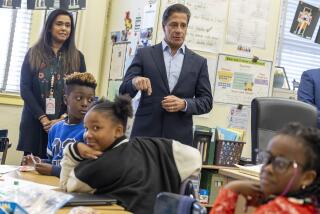Spare Time for Math : Bowling Program Lets Santa Ana Pupils Pick Up Lessons in Numbers
- Share via
SANTA ANA — With his brow knitted in concentration, Marco Arreguin, 9, stared at the white bowling pins at the end of the playground’s makeshift alley and lifted his ball in front of his face.
*
“Please let it be a strike,” he said to himself as he stepped forward and launched the scuffed plastic ball with a two-handed throw.
Seconds later, the ball spun to the center of the lane and scattered all 10 pins. “Yeah!” he shouted, punching the air and dancing a victory jig down the lane.
Although he may not have looked like it, Marco was learning math. He and other third- and fourth-graders at Wilson Elementary were participating in an innovative learning program--a kind of “Bowling for Scholars”--that lets students pick up math concepts along with strikes and spares.
Instead of sitting in a classroom and learning to compute averages from a list of random numbers, students take to the lanes and use math to determine how well they score during an average game, teacher Gail Dasno said.
As a result, each day’s lesson “is more effective because it relates to them. Since it’s their scores, they really want to know the answers,” she said.
Students also get to apply what they learn in class to the real world. For example, they used recent lessons about measurements and accuracy to determine whether their bowling alleys were 60 feet long, as the rules require. The idea is to get the children excited about learning by getting them personally involved in their lessons, Dasno said.
The program, created as part of a partnership between local bowling centers and the Santa Ana Unified School District, is now offered at 20 campuses throughout the year. The bowling centers provide the equipment and also offer occasional free games at their lanes for children and their parents. So far, the program, which has been running since last July, has kept the children enthusiastic about any schoolwork related to their new sport, Dasno said.
“They bug me every day: ‘When are we going to go bowling again?’ ” she said.
*
The program, which is sponsored in part by a local bowling center, originally focused on physical education. However, teachers soon realized they could easily use it to tie in math and problem solving, as well as boost children’s self-esteem. Dasno said that the program also teaches students sportsmanship, hand-eye coordination, cooperation and the importance of following rules.
On Wednesday, 32 children gathered into teams on the cement playground and tossed plastic bowling balls at the pins. In the absence of gutters and automatic pinsetters, the children picked up the scattered pins themselves and put them back into place, gleefully yelling encouragement to the next bowler.
Throughout the exercise, the students called out scores for the players’ frames so that they could calculate their averages later. Back in the classroom, they hunched over their score sheets and added up their strikes, spares and gutter balls. Then they divided them by the number of frames to determine their average and excitedly compared their statistics.
“I think a lot of kids like it,” said Vanessa Terrazas, 9. “When you’re doing it, people are all (yelling), ‘Yeah!’ and ‘Woo-woo!’ It’s really fun (but) you learn more about math.”
Adam Mendoza, 9, agreed. “I like to throw strikes. When I get it right, I feel happy.”
His love of the game has affected his schoolwork and made learning as easy as knocking down pins. “I didn’t know how to do division before,” he said. “Then I learned how to bowl and now I do.”
More to Read
Sign up for Essential California
The most important California stories and recommendations in your inbox every morning.
You may occasionally receive promotional content from the Los Angeles Times.













